
Proud of Our People! First Female Heroes of the Soviet Union
/ Главная / Russkiy Mir Foundation / Publications / Proud of Our People! First Female Heroes of the Soviet UnionProud of Our People! First Female Heroes of the Soviet Union
Anna Efremova
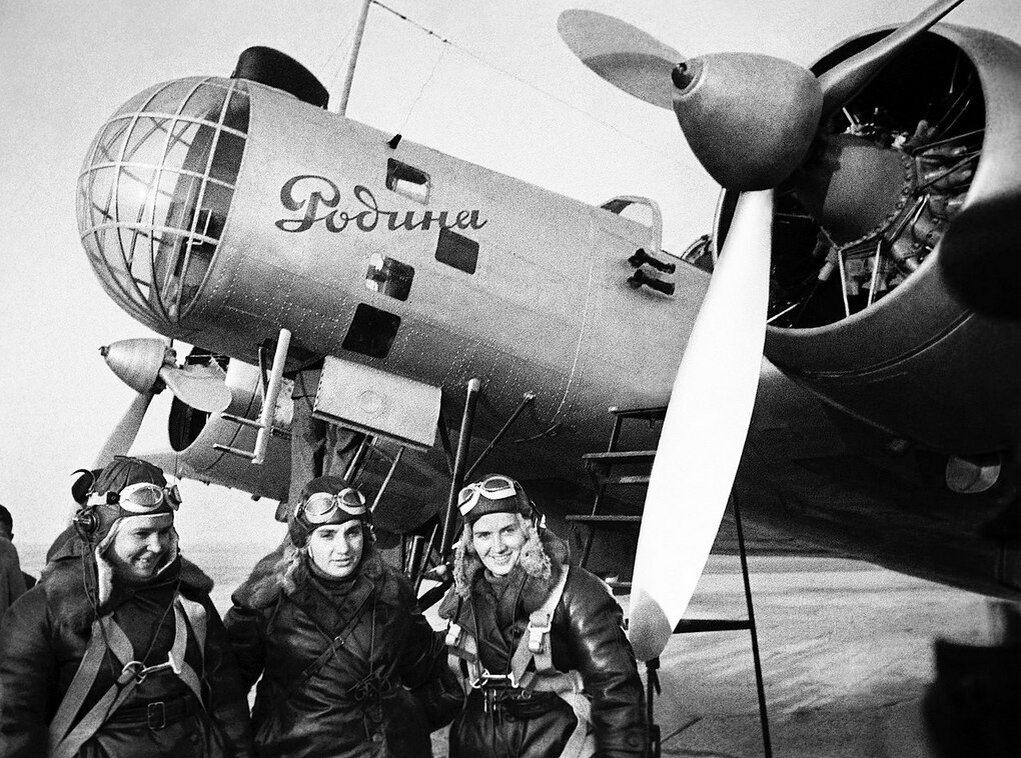
85 years ago, on November 2, 1938, a reception in honor of three aviatrixes - Valentina Grizodubova, Polina Osipenko, and Marina Raskova - took place in the Kremlin. They were the first women in the USSR to receive the title of Hero of the Soviet Union, the highest award of the young Soviet country. The aviatrixes were awarded for their flight from Moscow to the Far East on the Rodina aircraft. They flew 4,008 miles (6,450 kilometers) setting a range record.
Valentina Grizodubova: up in the sky since she was two
Valentina Grizodubova was born in Kharkov on May 10, 1909. Her father, Stepan Grizodubov, was not only a nobleman but also one of the pioneers of Russian aviation. The talented self-taught aviator was inspired by the Wright brothers' flight and spent all his money on designing airplanes. His wife helped him by sewing the sailcloth skin for the wind mainframes. She felt very confident in her husband. She did not even mind when he took his two-year-old daughter Valya on one of his flights on the biplane. This is how the soon-to-be most renowned aviatrix of the Soviet Union touched the sky for the first time. When she was 14 years old, she attended the meeting of gliders in Koktebel. She made her first flight in a glider there and met Sergei Korolev, a spacecraft designer-to-be.
In fact, Valentina did not recognize her calling right away. She finished music college specializing in piano and entered the Kharkov Conservatory. She also applied to the Kharkov Institute of Technology. Having studied in both Universities for a while, she made her choice in 1928. Valentina Grizodubova joined the first group of the newly opened aeroclub. She mastered the one-year program in three months. However, there were no possibilities of continuing airmanship training in Kharkov. So Valentina joined a sports pilot school in Tula and then entered the Penza School of Flight Instructors.
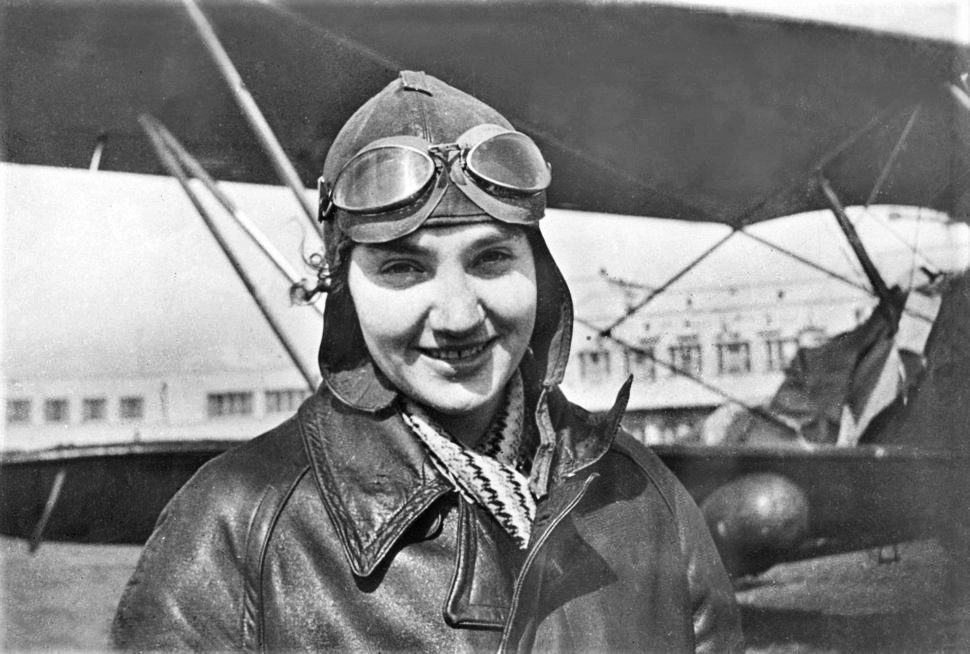
Valentina Grizodubova. Photo credit: The Central Air Force Museum
From 1930 to 1933 she worked as a flight instructor at the Tula Aeroclub and trained dozens of pilots-to-be. From 1934 she served in the Maxim Gorky Agitational Squadron that was based at the Moscow Central Aerodrome. Her flights covered almost the whole country. Thus, she proved that girls from distant villages and even from auls could have exciting and promising prospects.
It was an era of records in aviation. American pilots crossed the Atlantic Ocean for the first time, a French aviatrix set a record for women by flying more than 2,500 miles (4,000 kilometers) in an airplane. In June 1937, Soviet pilots Valery Chkalov, Georgy Baydukov, and Alexander Belyakov made the first non-stop flight from the USSR to the USA via the North Pole. In June 1938, Mikhail Gromov, a test pilot leading the crew of ANT-25-1, made an ultra-long non-stop flight from Moscow to the North Pole and to California (USA), having set three world aviation records.
The country was longing for new striking achievements and records, this time by women as their equal rights with men had been one of the USSR's main achievements. Women did not betray the expectations. Valentina Grizodubova wrote a letter to Mr. Stalin requesting the permission of a female crew to make a non-stop flight from the USSR to the USA. By that time Ms. Grizodubova was more than just an agitator pilot. In 1937, she set five world records for women on Yakovlev Light Utility aircraft. One of them was the line-of-sight range record when she flew from Moscow to Aktobe. She had already been honored with the Order of the Red Star for her achievements. Nevertheless, Valentina Grizodubova was not allowed to fly to the United States. She was suggested to fly to the Far East. She took Polina Osipenko as co-pilot and Marina Raskova as navigator.
"An aviatrix named Polina performed her glorious flight"
Polina Osipenko was the ninth child in a peasant family. Her education included elementary school and poultry farming courses. One day, the poultry farm worker saw an airplane landing in the neighborhood, and Zinaida Kokorina, the first Soviet aviatrix, stepped out of it. "I was very excited. It means women can also fly, can't they?!", Polina Osipenko later recalled. Her marriage to a military pilot played a decisive role in her career. He brought his wife to a settlement near Sevastopol, where the Kacha Military Aviation School was based.
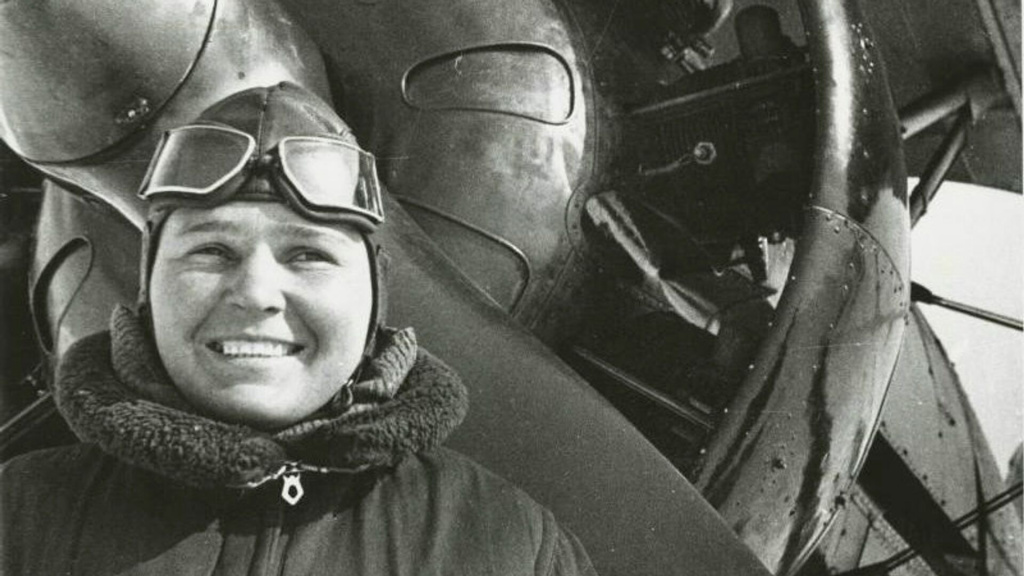
Polina Osipenko. Photo credit: ukraina.ru
Polina already knew she wanted to be an aviatrix. However, the Kacha School did not accept women. So, the girl got a job in the Aviation School's canteen. It turned out that the preflight breakfast was delivered to the pilots on Po-2. The male pilots saw Polina's keen interest and trusted her to control the airplane for a little while. Soon she was able to fly alone. When Klim Voroshilov, the People's Commissar of Defense, came to the Kacha Aviation School for an inspection, the courageous girl asked him for permission to become a trainee. Thus, her dream of becoming an aviatrix came true.
Having finished the Aviation School, Ms. Osipenko served in fighter aviation. There were not many women in aviation at that time, and Polina Osipenko could not ignore the record race. She set her first record on May 22, 1937. She reached an altitude of 29,000 ft (8,864 meters) in the open cockpit of a seaplane. The previous altitude record for women was exceeded by nearly 1.9 miles (3 kilometers)! A year later, Ms. Osipenko, together with Marina Raskova, navigator, and Vera Lomako, co-pilot, performed the flight from Moscow to Arkhangelsk, setting a new record for women in the seaplane class. All three aviatrixes were honored for the flight with the Order of Lenin. The poet Alexander Tvardovsky dedicated the poem "Polina" to the crew commander. It reads, "Over the great Russian plain, over the expanse of fields, woods, and waters, an aviatrix named Polina performed her glorious flight".
Marina Raskova: navigator of instrument flying
Navigator Marina Raskova was the youngest in the female crew - she was 26 only. The girl had been diagnosed with an absolute pitch when she was a child. Since her father served in the opera and taught private vocal lessons, it seemed that young Marina's career had already been chosen.
She studied at a music school and then entered a conservatory. However, as her father died, she had to start earning money on her own. After the 9th grade, she got a job as an intern at the Butyrsky Aniline Dye Factory. She got married quickly, and then gave birth to a daughter. Her life seemed to be settled. Nevertheless, Ms. Raskova became desperately bored at home. Later, she wrote in her book, "I was used to be with people, in a group." So, her brother found her a job in a laboratory at Zhukovsky Air Force Academy.
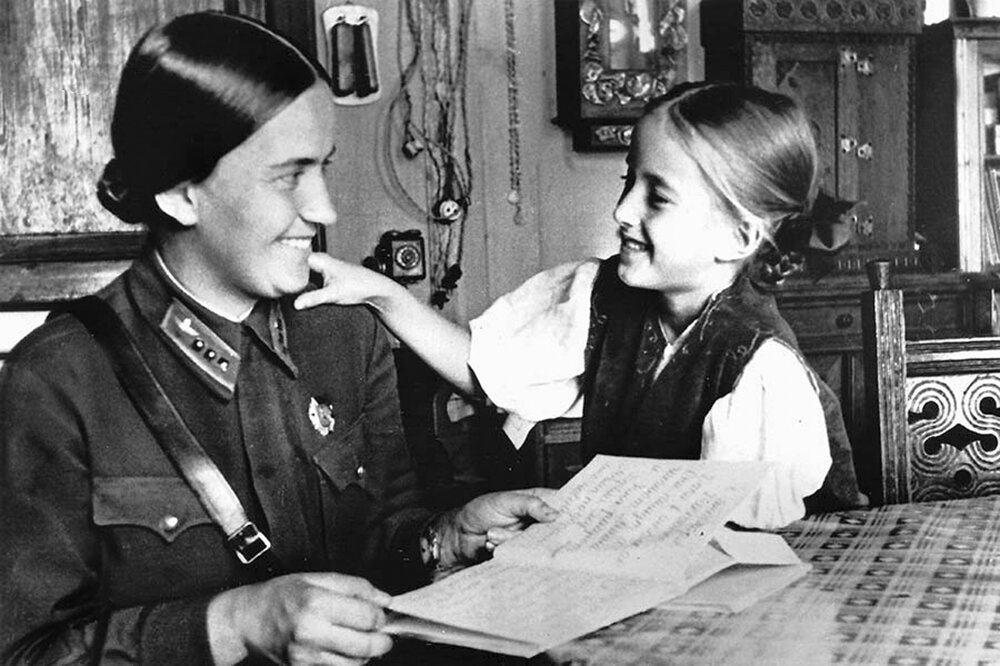
Marina Raskova with her daughter Tanya. Photo credit: Zen
Her work at the academy involved calculations that made so-called instrumental flying possible. It is relevant when such landmarks as roads and rivers are not visible due to the weather. Then she graduated from the Leningrad Institute of Civil Aircraft Engineers. It was followed by a pilot school at the Tushino airfield. In the fall of 1935, she became an instructor in instrumental flying at the Navigation Department of the Zhukovsky Academy. In 1937, she flew with Valentina Grizodubova to Aktobe. In 1938, she flew with Ms. Osipenko to Arkhangelsk. Three aviatrixes knew and trusted each other. They were willing to prove that they were the best.
Aviatrixes and their "Rodina"
Selecting the aircraft was the key issue. Three of them used to fly light airplanes. However, they were not designed for such a long-range trip. This task required military bombers. A month before the female crew's flight, the record for a non-stop flight to the Far East was set by the male crew of Vladimir Kokkinaki, a pilot, and Alexander Bryandinsky, a navigator. They flew on an airplane developed by the Ilyushin Design Bureau. The aviatrixes were assigned a twin-engine prototype of the ANT-37 long-range bomber developed by the Tupolev Design Bureau.
It was decided to prepare the unfinished airplane for the flight of the female crew. Four additional fuel tanks were installed on it, the engines were replaced with more powerful ones, and a reinforced landing gear was installed. By the way, it could be opened with a single button for the first time in the history of domestic aeronautical engineering. The aircraft got its name - "Rodina" (Homeland in Russian). Valentina Grizodubova was appointed the crew commander, Polina Osipenko was the co-pilot and Marina Raskova was the navigator. The aviatrixes were ready for their main record.
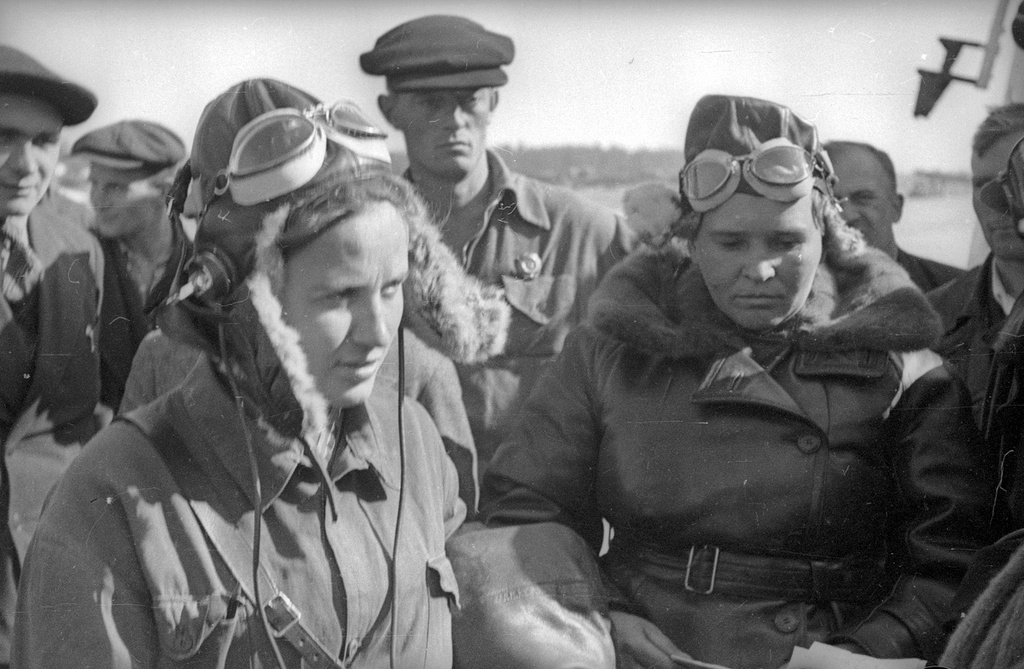
Navigator Marina Raskova and co-pilot Polina Osipenko at Shchyolkovo airfield. Photo credit: russiainphoto.ru
On September 23, 1938, the departure was approved. Early in the morning of September 24, the Rodina aircraft took off from Shchyolkovo near Moscow and headed for the Far East. The flight became death-defying almost immediately. There were dense clouds along the route. The crew commander Ms. Grizodubova decided to ascend as high as possible. However, the aircraft got covered with ice crust at the altitude. All radio equipment failed. At one point, Marina Raskova, the navigator, decided to open a cockpit window to get their geographical bearings, and all the maps with the route were blown away. The radio compass also ceased to operate. Nevertheless, the crew decided to continue the flight virtually blindly.
There were still 932 miles (1,500 km) to Komsomolsk-on-Amur when it became clear that the remaining fuel supply would last half an hour only due to icing and altitude gain. Ms. Grizodubova decided to make a belly landing having ordered Ms. Raskova to parachute out. Her navigator's cabin was under the aircraft's forebody and it would have certainly been destroyed during landing.
Valentina Grizodubova landed the plane in a swamp as the only flat ground in the taiga. Communication with the aircraft was lost but the young ladies believed that they would be found. The story development could make a good action movie. There was no communication with the crew for 10 days. Nobody knew whether the brave aviatrixes were alive. Nevertheless, huge efforts were made to find them. More than 50 airplanes, hundreds of unmounted units, trackers on horses and reindeer, fishermen on rowboats and motorboats took part in the search. On October 3, they were found by a surveillance biplane. By that time Marina Raskova had also joined her friends after 10 days of wandering in the taiga with only two chocolate bars in hand.
The heroic aviatrixes traveled from Khabarovsk to Moscow on a train decorated with flowers. Crowds of people and orchestras greeted them at every station. Tens of thousands of people stood along their entire route in Moscow. Dedicated stamps were issued to celebrate the flight. In 1939, "Taiga Friends" was released. It was one of the first color cartoons produced in the USSR.
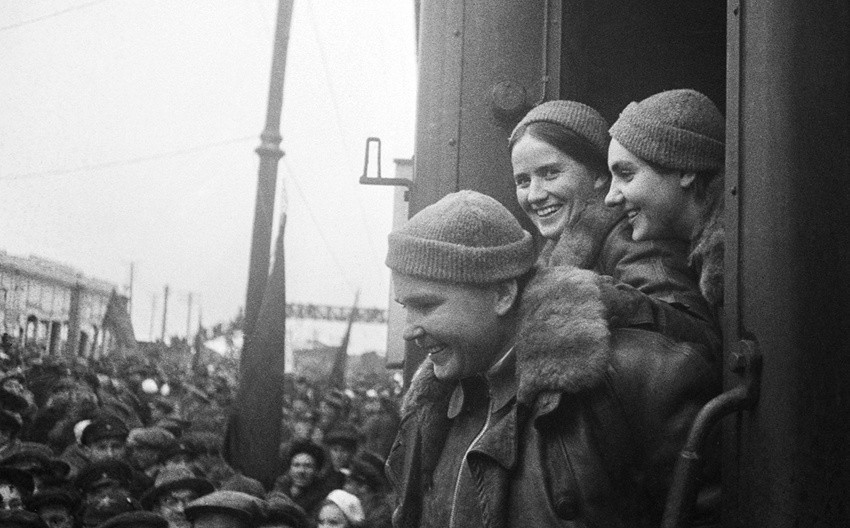
Valentina Grizodubova, Polina Osipenko, and Marina Raskova are welcomed at the Perm Train Station, 1938. Photo credit: russiainphoto.ru
After their triumph, the aviatrixes' lives took different turns. Polina Osipenko died in a crash during a training flight one year later. Once the Great Patriotic War broke out, Marina Raskova addressed Mr. Stalin with a suggestion to organize female combat units. She oversaw the forming of an air group of three female air regiments. In late 1942, having sent the first squadron to the front line near Stalingrad, Ms. Raskova planned to fly there as well. Unfortunately, on January 4, 1943, her Pe-2 got into a thick cloud and crashed.
Valentina Grizodubova's path was the most successful. She became the first female commander of the 101st Air Regiment of the Long-Range Aviation during wartime. Ms. Grizodubova had already completed about 200 combat sorties by May 1943. Hitler personally knew about the brave Russian aviatrix, and his aces were assigned the task of taking down Valentina Grizodubova's aircraft. Yet, the heavens and fortune kept her safe throughout the war. The famous aviatrix became Deputy Director of the top secret scientific research institute 17 that developed radar facilities after the war. She was honored with the title of Hero of Socialist Labor in 1986.
…There is another important detail of Valentina Grizodubova's personality. She wasn't afraid to take advantage of all her fame and power to help political prisoners. For example, she and Mikhail Gromov, a flying hero, managed to rescue her long-time acquaintance Sergei Korolev from the camp. Moreover, she took an active part in the destinies of almost 5,000 people. She passed away on April 28, 1993.
New publications

 Mikhail Kalatozov, a director who transformed the world of cinematography in many ways, was born 120 years ago. He was a Soviet film official and a propagandist. Above all, he was capable of producing movies that struck viewers with their power and poetic language.
Mikhail Kalatozov, a director who transformed the world of cinematography in many ways, was born 120 years ago. He was a Soviet film official and a propagandist. Above all, he was capable of producing movies that struck viewers with their power and poetic language.  Ukrainian authorities have launched a persecution campaign against the canonical Ukrainian Orthodox Church (UOC), the biggest one in the country's modern history. Over the past year, state sanctions were imposed on clergy representatives, searches were conducted in churches, clergymen were arrested, criminal cases were initiated, the activity of the UOC was banned in various regions of the country, and monasteries and churches were seized.
Ukrainian authorities have launched a persecution campaign against the canonical Ukrainian Orthodox Church (UOC), the biggest one in the country's modern history. Over the past year, state sanctions were imposed on clergy representatives, searches were conducted in churches, clergymen were arrested, criminal cases were initiated, the activity of the UOC was banned in various regions of the country, and monasteries and churches were seized.  When Nektary Kotlyaroff, a fourth-generation Russian Australian and founder of the Russian Orthodox Choir in Sydney, first visited Russia, the first person he spoke to was a cab driver at the airport. Having heard that Nektariy's ancestors left Russia more than 100 years ago, the driver was astonished, "How come you haven't forgotten the Russian language?" Nektary Kotlyaroff repeated his answer in an interview with the Russkiy Mir. His affinity to the Orthodox Church (many of his ancestors and relatives were priests) and the traditions of a large Russian family brought from Russia helped him to preserve the Russian language.
When Nektary Kotlyaroff, a fourth-generation Russian Australian and founder of the Russian Orthodox Choir in Sydney, first visited Russia, the first person he spoke to was a cab driver at the airport. Having heard that Nektariy's ancestors left Russia more than 100 years ago, the driver was astonished, "How come you haven't forgotten the Russian language?" Nektary Kotlyaroff repeated his answer in an interview with the Russkiy Mir. His affinity to the Orthodox Church (many of his ancestors and relatives were priests) and the traditions of a large Russian family brought from Russia helped him to preserve the Russian language.

 The leaders of the Friends of the Great Russia cultural association (Amici Della Grande Russia) in Italy believe that the Western policy of abolishing Russian culture in Europe has finally failed. Furthermore, it was doomed to failure from the beginning.
The leaders of the Friends of the Great Russia cultural association (Amici Della Grande Russia) in Italy believe that the Western policy of abolishing Russian culture in Europe has finally failed. Furthermore, it was doomed to failure from the beginning.  Name of Vladimir Nemirovich-Danchenko is inscribed in the history of Russian theater along with Konstantin Stanislavski, the other founding father of the Moscow Art Theater. Nevertheless, Mr. Nemirovich-Danchenko was a renowned writer, playwright, and theater teacher even before their famous meeting in the Slavic Bazaar restaurant. Furthermore, it was Mr. Nemirovich-Danchenko who came up with the idea of establishing a new "people's" theater believing that the theater could become a "department of public education."
Name of Vladimir Nemirovich-Danchenko is inscribed in the history of Russian theater along with Konstantin Stanislavski, the other founding father of the Moscow Art Theater. Nevertheless, Mr. Nemirovich-Danchenko was a renowned writer, playwright, and theater teacher even before their famous meeting in the Slavic Bazaar restaurant. Furthermore, it was Mr. Nemirovich-Danchenko who came up with the idea of establishing a new "people's" theater believing that the theater could become a "department of public education."  "Russia is a thing of which the intellect cannot conceive..." by Fyodor Tyutchev are famous among Russians at least. December marks the 220th anniversary of the poet's birth. Yet, he never considered poetry to be his life's mission and was preoccupied with matters of a global scale. Mr.Tyutchev fought his war focusing on relations between Russia and the West, the origins of mutual misunderstanding, and the origins of Russophobia. When you read his works today, it feels as though he saw things coming in a crystal ball...
"Russia is a thing of which the intellect cannot conceive..." by Fyodor Tyutchev are famous among Russians at least. December marks the 220th anniversary of the poet's birth. Yet, he never considered poetry to be his life's mission and was preoccupied with matters of a global scale. Mr.Tyutchev fought his war focusing on relations between Russia and the West, the origins of mutual misunderstanding, and the origins of Russophobia. When you read his works today, it feels as though he saw things coming in a crystal ball...